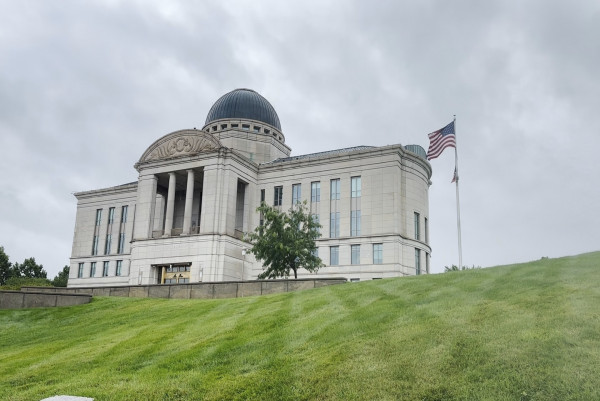Several lawmakers are voicing concerns about the deficit impact of the “One Big Beautiful Bill” (OBBB) while others are more dismissive. Some claim that the bill will reduce deficits because of robust growth in the economy and taxA tax is a mandatory payment or charge collected by local, state, and national governments from individuals or businesses to cover the costs of general government services, goods, and activities.
revenues and because the cost of extending the expiring provisions of the Tax Cuts and Jobs Act (TCJA) should be ignored. We find that OBBB would increase economic output but worsen deficits, using dynamic estimates that account for economic growth. Our estimates are largely consistent with other dynamic analyses produced so far.
Estimated Economic Effects of the One Big Beautiful Bill
Source: Tax Foundation analysis.
Tax Foundation Estimates
At a high level, the House and Senate versions of OBBB would increase economic output to a similar degree over the short run, but the Senate bill would produce a more sustained boost over the long run by providing better and more stable incentives for capital investment. Over the long run, we find the House bill would increase GDP by 0.8 percent and the Senate bill would increase long-run GDP by 1.1 percent.
The main difference is that the Senate bill makes permanent the House bill’s temporary provisions allowing companies to immediately expense investment in equipment and short-lived assets and domestic research and development (R&D). Both bills prevent large tax increases on individuals that would otherwise occur at the end of this year due to the expiration of the TCJA’s lower tax rates, boosting labor supply and GDP.
Both bills include temporary tax cuts that further stimulate growth in the short run, such as expensing for qualified structures and a new deduction for overtime income. We estimate the Senate bill would increase GDP by about 1.0 percent on average over the budget window (2025-2034), so that average annual GDP growth increases by about 0.1 percentage points, increasing dynamically measured tax revenue and reducing the cost of the bill by $905 billion. The House bill would have a similar, but slightly smaller, increase in economic growth over the budget window, reducing the cost of the bill by $895 billion.
Joint Committee on Taxation (JCT) Estimates
The Joint Committee on Taxation (JCT) has produced a dynamic macroeconomic analysis of the bill as passed by the House Ways and Means CommitteeThe Committee on Ways and Means, more commonly referred to as the House Ways and Means Committee, is the chief tax-writing committee in the US. The House Ways and Means Committee has jurisdiction over all bills relating to taxes and other revenue generation, as well as spending programs like Social Security, Medicare, and unemployment insurance, among others.
so it does not capture the effects of changes made before the bill passed the full House. JCT estimates the bill would increase GDP by 0.4 percent on average over the next decade, with stronger growth in the first five years versus the second five years. That growth results in increased dynamic tax revenue, reducing the cost of the bill by $103 billion over the budget window. By the third decade, JCT predicts GDP would fall below baseline projections.
JCT’s estimate comes from averaging the results of their three macroeconomic models, with each model employing different assumptions about how taxpayers expect policy to change, how the Federal Reserve responds, and how much deficit borrowing crowds out private investment. JCT’s overlapping generations (OLG) model is closest to Tax Foundation’s, as it assumes expiring provisions expire so taxpayers are surprised by the bill’s extension of TCJA’s tax cuts, resulting in a large increase in labor supply. Conversely, JCT’s other two macro models assume taxpayers expect the tax cuts will be extended to some degree, so they produce a more muted economic effect that brings the average effect down.
Unlike Tax Foundation’s model, JCT’s OLG and other models include, to various degrees, a crowd-out effect that increases over time, further muting the results (but the magnitude is unclear). JCT’s OLG model estimates the bill would increase GDP by about 0.7 percent on average over the next decade, which is somewhat lower than our model estimates. JCT models crowd out based on deficits that result from the tax provisions, not accounting for the $1.5 trillion in spending offsets, thus overstating the bill’s deficits and associated crowd-out effects.
JCT’s estimated economic impact of the bill is smaller than the effect it estimated for permanence for the TCJA’s individual provisions alone (0.5 percent over the budget window, generating $372 billion of dynamic revenue). On net, JCT found the bill would shrink the capital stock by 0.1 percent over the budget window, whereas JCT found extending TCJA’s individual provisions alone would increase the capital stock by 0.3 percent. It is difficult to tell what drives the difference. Some possibilities could be changing assumptions about taxpayer expectations or crowd out, or specific policy differences, including the bill’s tax increases on foreign-headquartered multinational firms and repeal of green energy tax credits.
Congressional Budget Office (CBO) Estimates
The Congressional Budget Office (CBO) analyzed the House bill’s tax and spending provisions, estimating they would increase GDP by an average of 0.5 percent over the next decade. Overall, higher economic output would increase dynamic tax revenue and reduce the cost of the bill by $124 billion. The boost to GDP would be front-loaded, peaking at 0.9 percent in 2026, due to an increase in aggregate demand arising from an increase in most households’ income after taxes and transfers. While the bill’s temporary expensing and other provisions would initially boost the capital stock, by 2034, the effect would be offset by increased deficit borrowing crowding out private investment. CBO estimates interest rates would be higher, causing interest payments on the debt to increase by $441 billion over the next decade, more than offsetting the dynamic revenue effect.
Inclusive of interest payments and economic growth effects, CBO estimates that the House bill would cause publicly held debt as a share of GDP to increase about 7 percentage points to 124 percent by 2034, whereas we estimate it would increase about 3 percentage points to 120 percent.
Council of Economic Advisors (CEA) Estimates
In contrast to the variety of estimates indicating modest increases in economic growth, the Trump administration’s Council of Economic Advisors (CEA) published an analysis indicating OBBB would lead to an economic boom, with GDP increasing by 4.6 to 4.9 percent over the next four years and by 2.4 to 2.7 percent by 2034. However, many of the modeling assumptions tend to overstate the economic impacts.
While the analysis accounts for reduced marginal tax rates on work resulting from the House and Senate bill’s individual tax cuts, it does not account for increased marginal tax rates on work and housing investment resulting from limitations on itemized deductions for state and local taxes (SALT) and mortgage interest—a large negative effect in our analysis.
Most of the GDP growth estimated by CEA results from the individual tax cuts specified in the Senate bill. That’s especially true in the short run, as CEA assumes a large stimulus effect from increased consumer spending that alone represents about half of the total short-run GDP impact. However, CEA overstates the bill’s net individual tax cuts at $491 billion per year by ignoring many of the bill’s tax hikes on individuals, such as limitations on credits for health insurance and green energy, which reduce the net individual tax cuts by about 10 percent. CEA’s stimulus effect does not account for the bill’s reductions in spending, which further shrinks the size of the stimulus by about 20 percent.
Even with these lofty growth assumptions, CEA estimates OBBB will add $1.1 trillion to deficits over the next decade, resulting in a debt-to-GDP ratio that is roughly unchanged over the budget window.
Other Independent Estimates
Other independent analyses of OBBB are more consistent with Tax Foundation’s, JCT’s, and CBO’s rather than CEA’s. For example, the American Enterprise Institute’s Kyle Pomerleau estimates the House bill would increase GDP by 0.6 percent on average over the next decade and by 0.3 percent over the long run, reducing the cost of the bill by $356 billion over the next decade.
The Penn Wharton Budget Model (PWBM) estimates the House bill would increase GDP by 0.4 percent by 2034 but decrease hours worked, causing the cost of the bill to increase by $411 billion over the budget window. The Budget Lab at Yale (TBL) estimates the House bill would initially increase GDP by 0.6 percent by 2027 but reduce GDP by 0.1 percent by 2034, with no dynamic impact on primary deficits over the budget window. Similar to JCT’s and CBO’s qualitative analysis of the long run, PWBM and TBL both estimate negative GDP impacts of the bill after three decades, due to strong assumptions about monetary policy, bond markets, and interest rates—factors that are difficult to predict even one year to the next, much less 30 years from now.
Conclusion
A systematic analysis of the administration’s economic policies outside of OBBB, including tariffs, immigration, and deregulation, has not been produced, in part because of a lack of specificity on other policies. In the same report referenced above, CEA provides a partial analysis, claiming OBBB’s deficit impact would be more than offset by the economic and fiscal impacts of the administration’s efforts to deregulate, cut additional spending, and raise tariffs. However, while claiming $2.8 trillion in deficit reduction from new tariffTariffs are taxes imposed by one country on goods imported from another country. Tariffs are trade barriers that raise prices, reduce available quantities of goods and services for US businesses and consumers, and create an economic burden on foreign exporters.
revenues, CEA treats this policy as having no economic downside despite much evidence to the contrary.
The administration has claimed the combined policies would lead to much stronger economic growth of about 3 percent per year, versus 1.8 percent under the baseline, sufficient to offset the fiscal cost of the bill. Economic forecasters do not see such a sustained economic boom on the horizon but instead expect an economic slowdown this year, due in part to the administration’s tariffs, and then a return to something like baseline growth thereafter. While the tariff proposals continue to evolve, our estimates indicate they would generally offset much of the economic and fiscal impacts of OBBB while they are in place.
Lawmakers are right to be concerned about deficits and economic growth. The best path to address those concerns is to ensure OBBB provides permanent full expensing of capital investment, avoids inefficient tax cuts, and offsets remaining revenue losses by closing tax loopholes and reducing spending.
Stay informed on the tax policies impacting you.
Subscribe to get insights from our trusted experts delivered straight to your inbox.
Subscribe
Share this article





























